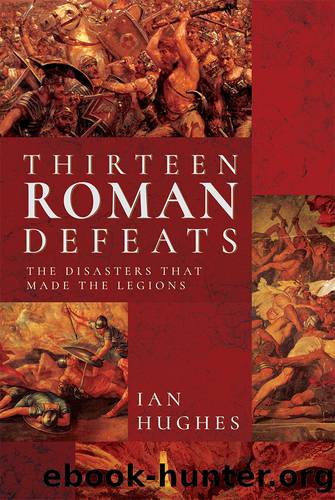Thirteen Roman Defeats by Ian Hughes;

Author:Ian Hughes;
Language: eng
Format: epub
Tags: HISTORY / Military / Ancient
Publisher: Casemate Publishers & Book Distributors, LLC
Published: 2023-08-30T00:00:00+00:00
Kalkriese Excavations: https://www.kalkriese-varusschlacht.de/en/the-park/the-rampart/#:~:text=The%20rampart%20is%20one%20of%20the%20most%20important,sods%20not%20long%20before%20the%20Roman%20soldiers%20arrived
Chapter Eight
The Gothic Threat: The Battle of Abritus, 251 CE
Sources
The Battle of Abritus was fought in 251 CE at the apex of the âThird Century Crisisâ, during which period the Empire came close to extinction and can be seen as the point at which the Empire could either fall or resurrect itself in a new form. Thirty-three years later the Emperor Diocletian would choose the latter course. The battle was fought in a confused and disjointed period, and sadly the sources follow the national trend in being confused, disjointed and often contradictory.
There are two writers whose work has survived in large part, plus a few whose work is fragmentary and several others whose coverage is so brief as to be of little use in analyzing the battle. Both of the extant sources are âGreekâ in origin, being written in the sixth century in the Eastern Empire. Obviously this means that both were composed much later than events and so relied upon lost works for their information. Consequently it is impossible to state with confidence that they are accurate.
The one with the most detail and hence the one that will form the core of the description is that of Zosimus. Writing at some point around the turn of the sixth century, Zosimus was a pagan and was extremely critical of Christianity. Due to the late date of composition, the accuracy of the description is unclear, but due to the paucity of sources it must be used in order to give an idea of how the battle unfolded.
The other major source was Jordanes, a Roman of possible Gothic descent who wrote a History of Rome and a History of the Goths. His work is valuable as, along with Isidore of Seville, he was one of only two writers who attempted to write a history of the early Goths. Sadly, his bias towards the Goths and the fact that his work was much later than the events described mean that he must be used with caution.
Of possible equal importance to the above is the account written by Publius Herennius Dexippus. Written by a contemporary, this work would be of great value if it was complete, but sadly the text is so fragmented that modern authorities are still debating whether it is a chronicle or a history. It should probably supersede Jordanes who was writing much later, but due to its fragmentary condition it is difficult to analyze in detail.
Other sources, for example Sextus Aurelius Victor, may give some details, but these are usually either fragmentary or so brief as to be of little use in detailing events of the battle or simply repeat the information included in the sources already listed. Where these are utilized, their usefulness will be assessed within the text.
Background
Following two centuries of stability, in 235 CE the last of the Severan Dynasty, Alexander Severus, was assassinated. He was replaced by Maximinus Thrax (âthe Thracianâ), who over the ensuing few years instituted payments of âsubsidiesâ to the Sasanids,
Download
This site does not store any files on its server. We only index and link to content provided by other sites. Please contact the content providers to delete copyright contents if any and email us, we'll remove relevant links or contents immediately.
The Radium Girls by Kate Moore(11785)
100 Deadly Skills by Clint Emerson(4765)
Rise and Kill First by Ronen Bergman(4617)
The Templars by Dan Jones(4578)
The Doomsday Machine by Daniel Ellsberg(4332)
The Rape of Nanking by Iris Chang(4069)
Killing England by Bill O'Reilly(3912)
Hitler in Los Angeles by Steven J. Ross(3834)
Stalin by Stephen Kotkin(3792)
12 Strong by Doug Stanton(3441)
Hitler's Monsters by Eric Kurlander(3212)
Blood and Sand by Alex Von Tunzelmann(3087)
Darkest Hour by Anthony McCarten(3028)
The Code Book by Simon Singh(2956)
The Art of War Visualized by Jessica Hagy(2869)
Hitler's Flying Saucers: A Guide to German Flying Discs of the Second World War by Stevens Henry(2652)
Babylon's Ark by Lawrence Anthony(2468)
The Second World Wars by Victor Davis Hanson(2440)
Tobruk by Peter Fitzsimons(2397)
